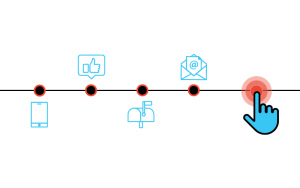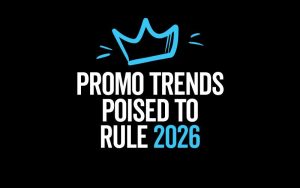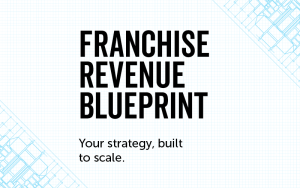Highlights:
- Multi-touch marketing uses repeated exposures across channels to build familiarity.
- It follows the Rule of 7—audiences need to see your message multiple times.
- Combining digital, social, and print strengthens recall and drives action.
[Revamped for 2025]
What’s your media channel of choice? Do you prefer a curated email in your inbox, or would you rather flip through a magazine for inspiration? Some people are visual learners, and some people are tactile learners—and their media preferences reflect that. So why not have your communications cater to your audience in ways that really resonate? And why not surround this audience with messaging that reaches out and touches them throughout their day, giving them a complete brand experience that builds loyalty and trust?
It takes about five to seven brand impressions for someone to actually remember a brand—this is often called the “Rule of 7.” For that same person to take the next step and purchase from the brand, it can take as many as 28.87 exposures according to this LinkedIn post, which brilliantly touches upon the MANY different factors that can affect action, from industry type to customer journey stage, to product sales cycle, and more. There’s no hard and fast rule for how many impressions you’ll need, and it will vary with every campaign. The bottom line? You need to reach out and touch someone many different times before they decide to buy.
Enter the power of “multi-touch marketing.”
Messages, Messages Everywhere
As you’re well aware, digital communications and social media have significantly transformed marketing and the ways that consumers buy products and support brands. As it’s evolved, this digital landscape has become more than just a process; it’s a total experience. Consumers are bombarded every moment by myriad marketing messages as different brands and businesses try to beat out the competition. A brand needs to work hard to stand out in a crowd. But how? A more personalized approach can make all the difference. Enter multi-touch.
The Makings of Multi-Touch
Let’s take a step back to understand how a multi-touch campaign works. It’s a strategy that delivers your marketing messages through multiple channels throughout a prospect’s day, in a coordinated and intentional way (known as omnichannel marketing). With multi-touch, you are “touching” your audience at different points in their lives.
The goal is to create a seamless, consistent experience, whether that touchpoint is digital or physical. Viewership of your message increases because you’re extending your reach and “touching” people who use different types of media. So, you’ll achieve maximum brand exposure, which leads to greater leads and the all-important sales increases!
What’s an example of a multi-touch strategy? Picture using a mix of direct mail, social media, and large format signage to reach your prospect throughout the day. The goal is to make it a seamless experience that your prospect doesn’t even notice; it’s just a natural progression as she moves from her home to her office to the errands afterwards.
Related: 8 Ways to Master the Multi-Channel Marketing Mix
Planning a Multi-Touch Campaign
Consider the learning types we explored earlier, and tailor your omnichannel campaign to those too. While you can’t know everyone’s styles, you can provide a variety of media formats to cater to the different styles. For instance, visual learners are drawn to social media platforms that feature online video advertisements or large signage that stops them in their tracks, while tactile learners appreciate direct mail, booklets, and brochures that they can hold in their hands.
But with all of these media options and plenty of noise, how does a marketer develop a successful multi-touch marketing campaign?
To build a campaign that resonates and performs, plan with intention and structure:
- Research First: Identify what channels (say magazines versus social media) and devices (mobile versus desktop) your audience is most likely to frequent. For example, list the social media channels most likely to resonate with your specific audience by selecting the ones generating the highest engagement numbers.
- Strategy Second: Create a smart omnichannel campaign strategy that defines your goals—whether it’s brand awareness, lead nurturing, or conversion—and identifies your best prospects. Map out the buyer journey, align messaging to each stage, and define campaign timing that aligns with decision-making behavior.
- Tactics Third: Choose the right mix of channels for maximum reach and resonance. Go beyond the usual suspects—email, social, direct mail, paid ads—and think about where your personas spend time and how they interact in those spaces.
- Tracking and Refining Last: Build in A/B and multivariate testing to compare creative, channels, and cadence. Use those insights to refine messaging and optimize the campaign while it’s live—not just afterward.
Related: Go Omnichannel with the Right Channels
Why Multi-Touch Marketing Increases Reach and Impact
There’s no doubt that multi-touch campaigns increase your reach to your target consumer and ultimately have a greater impact. Combining digital and physical marketing throughout the day helps to increase your reach to your target consumer and deliver the media that works best for them. Furthermore, by targeting consumers that view the same ad multiple times in various places (like on social media and then on an outdoor banner), you’re building brand awareness and encouraging loyalty and trust.
Developing a successful omnichannel marketing campaign is not simple. We’ve learned it can be a 28.87 step journey! But we can simplify it for you. We’ve helped brands across industries elevate their awareness and increase their sales with strategically built multi-touch campaigns that create seamless experiences for customers. Whether you have one location or many, we can help you master the multi-touch mix that resonates with your prospects throughout the day and provides the formats that fit them best. Reach out today to multi-touch your audience.




